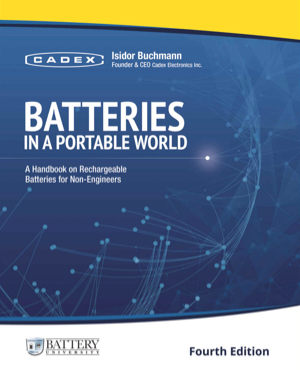Reliability-centered maintenance (RCM) is a maintenance strategy that provides continuous system dependability with a minimal level of maintenance. RCM started in the 1960s and was adopted by the airline industry in the 1970s. The military followed in the 1980s and in the 1990s the process spilled into civil users, such as nuclear power plants, oil & gas, subways, hospitals and more. Defined by the technical standard SAE JA1011, RCM provides risk awareness that improves reliability while reducing the need for invasive maintenance and lowering operational costs.
“Fix it when broken” worked with old machinery. With air travel, this method no longer applies and United Airlines was the first company to adopt RCM for safety reasons. The design of modern aircraft and new machinery now harmonize with RCM to streamline maintenance.
RCM will also work to maintain batteries once dependable diagnostic methods become available to measure state-of-health (SoH). But technology is lagging due to complexity and volatility in analysis. Battery performance indicators change when fully charged, empty, agitated or put into storage. Batteries carry the “black box” syndrome and do not reveal their condition to the naked eye. A pack looks the same when fully charged or empty, new or in need of replacement. In comparison, a car tire distorts when low on air or indicates end-of-life when the treads are worn.
Batteries are often installed and forgotten. A new battery starts with a capacity of 100% and fading goes unnoticed at first. Similar to a mechanical part, batteries can also fail prematurely especially if unduly stressed. Considering the growing importance, batteries should receive the same treatment as a critical part in an aircraft or machine in which wear and tear falls under strict maintenance guidelines.
Regulatory authorities are aware of battery shortcomings and this is especially apparent in healthcare. Unlike pharmaceutical products that are tightly regulated, batteries are not well controlled. A biomed technician said: “Batteries are the most abused components; staff cares little about them and only does the bare minimum.” The whistleblower goes on to say that: “References to battery maintenance are vague and hidden inside service manuals.”
AAMI (Association for the Advancement of Medical Instrumentation) rates battery management as one of the top 10 challenges. An FDA survey reveals that up to 50% of issues in hospitals are battery related. FDA points to deficiency in battery quality assurance by device manufacturers, lack of understanding in battery systems integration, and not knowing the end of battery life.
Discussing battery issues with Biomedical Technicians
A retiring biomed technician recently organized a workshop in a large hospital in Michigan to discuss battery problems in healthcare. The participants were experienced biomed techs; mostly aged 50 with plenty of hands-on experience. Cadex Electronics participated by asking questions to assist in developing new battery diagnostic technologies. Cadex also participated in a similar workshop in Belgium to learn about battery problems in Europe.
- Are batteries a problem in medical devices? Do you trust them?
There is a general distrust in batteries and the bio-med techs agree with the FDA’s statement that up to 50% of issues in hospitals are battery related. Having been a service technician myself, I know well that battery failure accounts for about half the service calls. - Who is responsible for the battery in a medical device?
Here, battery-fit plays a role. If the battery is built into a device, the responsibility to test and replace a battery goes to the technician. The procedure changes if the battery is removable for charging. Devices with removable batteries have an advantage in that the user can replace an empty pack with a charged one, check it with a battery analyzer and retire when faded without the involvement of service. - When should a battery be replaced? What percentage denotes end-of-life?
The answers were mixed. Unless checked with a battery analyzer, the capacity is not known. Batteries come oversized to allow for some fading; end-of-life is commonly at 80%. Battery capacity should be verified as part of servicing a device and before replacing the pack. - What are the regulatory procedures in battery testing?
In the absence of a battery analyzer, device manufacturers recommend replacing batteries on a date stamp that allows for 2 and 3 years of service. Fabrication-to-destination causes delay and a battery can be one year old when entering service. Date stamping leads to discarding of good batteries. After two years in service, the capacity of a defibrillator battery can still be over 90%. A manager at DOE discovered that every year about one million usable lithium-ion batteries are discarded.
Device manufacturers are aware of high replacement costs when many packs are under-utilized. As a general guideline, lead- and nickel-based batteries are good for about 3 years, but Li-ion can last for more than five years. In contrast, batteries for the electric vehicle are guaranteed for eight years. This longevity is also attainable in healthcare with diagnostic equipment. To demonstrate battery endurance, the organizer for this workshop reused spent batteries from patient heart pumps to cut the grass with his electric lawn mower. - Do you follow the date stamp or use common sense when replacing a battery?
Here the philosophy differed. One gentleman said he replaces the battery according to the mandated date stamp but most others use common sense, provided the evidence can be proven. Medical device manufacturers are aware of the shortcomings of date stamping and some have relaxed the policy. - How do you check battery capacity?
Many batteries and portable devices include a fuel gauge showing battery state-of-charge (SoC). While this is helpful, the readout does not guarantee runtime. A serious error occurs if an aged battery shows 100% SoC while the capacity has dropped to 50%. In this case, the runtime is cut in half. We ask, “100% of what?”Unless checked with a battery analyzer, the true capacity remains unknown. Capacity is the leading health indicator that also determines end-of-life. When I ask battery users: “At what capacity do you replace the battery?” most reply in confusion: “I beg your pardon?” 
Figure 1: SoC is not enough - What are the benefits of the smart battery?
Modern devices are equipped with smart batteries offering state-of-function (SoF) that is instantly readable. FCC (Full Charge Capacity) in a smart battery represents the “digital capacity” that correlates to the “chemical capacity.” The battery also has a digital serial number to track history with a database.
But the smart battery has room for improvement. Few medical devices present SoF in an easy to read format. SoF may only be accessible by an access code because manufacturers serving the consumer market are hesitant in offering too much information in fear of increased warranty claims. Biomeds also say that the “digital battery” causes more problems than the “chemical battery.” For safety reasons, many chargers are hybrid and switch to regular charging when the digital communications fails. - Would the Fishbowl work?
As presenter at the workshop, I proposed the Fishbowl (Figure 2) to provide battery SoF graphically. The icon shows SoC by the Charge Ring that moves counter-clockwise towards the Charge Alarm on discharge. The Status Dome spells out the battery status; Battery Fade is shown by a dropping ceiling in the Dome. End-of-life occurs when Battery Fade reaches the Pass/Fail line. Pressing the Dome on a touchscreen shows the Detailed Battery Information (Table 4). Figure 3 illustrates typical battery conditions portrayed at a glance.
Figure 2 Fishbowl reveals SoF 
Figure 3: Fishbowl shows battery status everyone can understand. Touching the Dome reveals detailed information. Legend
Table 4: Detailed Battery Information of a SMBus battery as presented in the Cadex Cloud.
SoC: State-of-charge
SoH: State-of-health; mainly based on capacity
SoF: State-of-function
FCC: Full charge capacity; relates to battery capacity
The biomeds found the Fishbowl too complex and suggested a one-sentence message instead. But this would not give sufficient information with multiple deficiencies and cause problems in a non-English speaking world. With familiarity, the Fishbowl will provide a quick and easy SoF readout to make the battery transparent.
It became apparent that not all biomeds are familiar with SMBus. This void was also noticed at our presentation in Belgium. It is unfortunate that device manufacturers are hesitant to utilize SMBus data for the benefit of the user. Intelligence is locked up and the battery remains a black box. With the ability to read embedded SoF information, smart batteries only need a full cycle for calibration and verification of capacity before replacement. Service tools, such as battery analyzers, keep batteries in service longer, improve system reliability and cut operational costs. - How beneficial is a database?
The Cadex Cloud is an online database that shares battery test results with battery users, technicians and fleet supervisors. Packs that drop below a user-set target capacity are identified and replaced. The system also records the energy consumed by reading SoC before charge. Packs returning with low spare charge can be tracked as part of risk management. An analogy is an aircraft carrying enough fuel to anticipate headwinds and a second landing approach. Figure 5 illustrates two-way communications using a computing device. 
Figure 5: Cadex Cloud serves as supervisor - How well are medical batteries documented?
The workshop revealed that the healthcare industry requires minimal battery documentation. There are no set standards and little is done to track performance history. Service tools to assist in service and documentation of batteries will likely come from the private sector and go beyond healthcare.
Summary
RCM gained prominence with air transport in decreasing failure and reducing maintenance costs. Batteries are also gaining importance but before RCM can be implemented in earnest, more effective battery diagnostic technologies must be developed. Batteries use different criteria than wear and tear on a mechanical part and observe capacity, internal resistance and self-discharge.
- Capacity represents storage capability that is difficult to measure on the fly. Coulomb counting is well-suited to measure the capacity of Li-ion. Electrochemical impedance spectroscopy (EIS) checks lead acid and Li-ion by a frequency scan.
- Internal resistance governs current delivery. Ohmic values are simple to read but the numbers do not correlate with capacity. Resistance tends to stay low throughout life while capacity drops predictably as part of usage.
- Self-discharge reflects the mechanical integrity of a cell. Li-ion has low self-discharge; elevated self-discharge hints to stress-related damage than can compromise safety. Modern battery analyzers measure capacity, internal resistance and self-discharge.
Reducing our dependency on fossil fuels places new responsibilities on the battery. Advancements in Diagnostic Battery Management (DBM) will eventually usher in RCM as a battery maintenance tool.
Improvements in batteries do not rest in higher capacity alone, but in delivering a dependable and safe energy source over the entire service life of the battery. DBM assists in battery development by keeping batteries in service longer, lowering operational costs and reducing the environment impact of fabricating and disposing of batteries.
About the Author
Isidor Buchmann is the founder and CEO of Cadex Electronics Inc. For three decades, Buchmann has studied the behavior of rechargeable batteries in practical, everyday applications, has written award-winning articles including the best-selling book “Batteries in a Portable World,” now in its fourth edition. Cadex specializes in the design and manufacturing of battery chargers, analyzers and monitoring devices. For more information on batteries, visit www.batteryuniversity.com; product information is on www.cadex.com.

